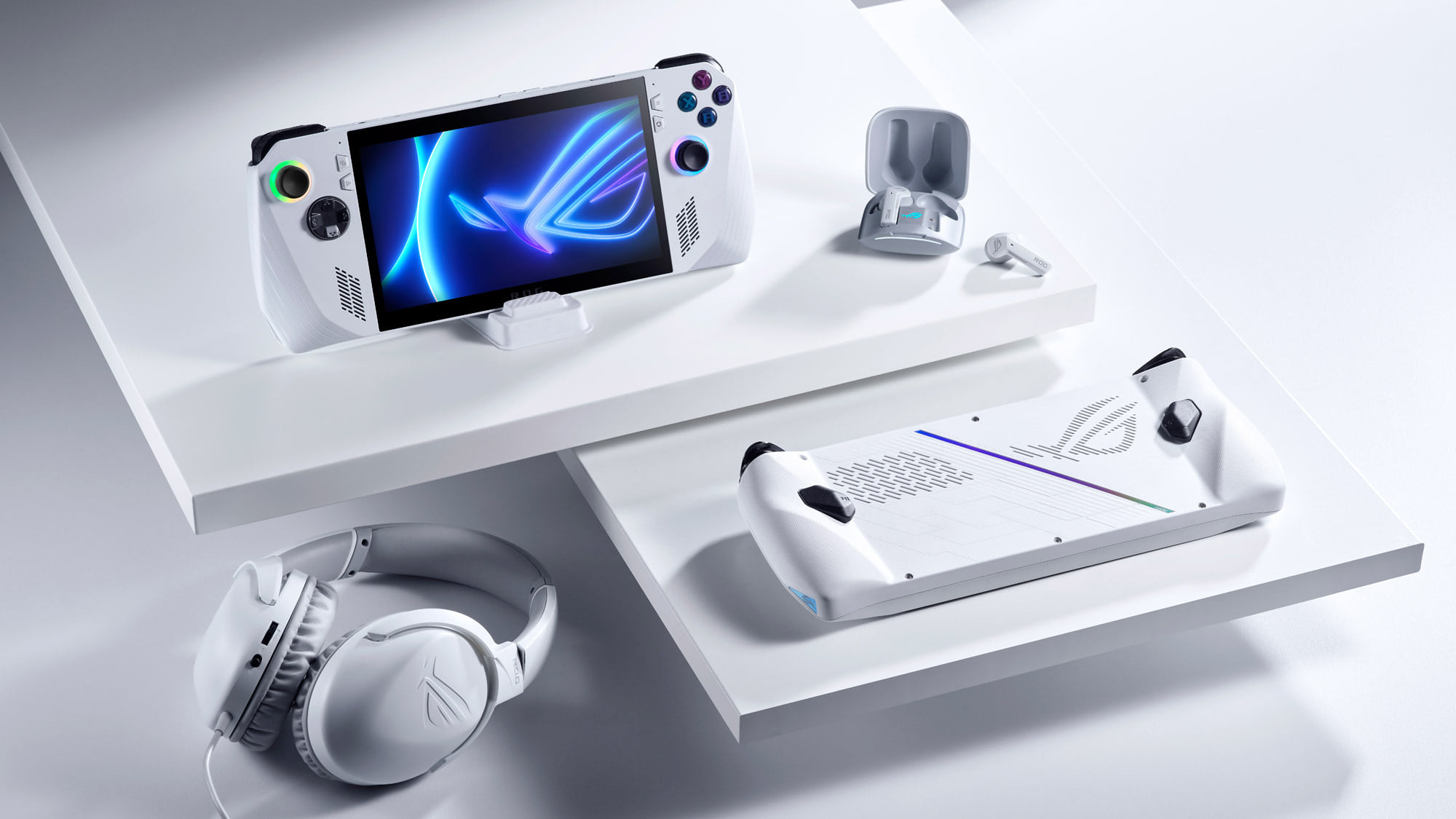Introduction
The handheld gaming PC market is booming, offering gamers the freedom to enjoy AAA titles and indie favorites on the go. Two of the most prominent contenders in this space are the Asus ROG Ally and the Steam Deck, each carving out its niche with unique features and capabilities.
The Asus ROG Ally brings PC gaming power to the palm of your hand, boasting high-performance hardware, a sleek design, and Windows 11 compatibility. With its AMD Ryzen Z1 Extreme APU, vibrant display, and support for various game stores, the ROG Ally is tailored for gamers seeking versatility and performance.
The Steam Deck, developed by Valve, revolutionized portable gaming with its SteamOS, robust library support, and affordability. Designed with comfort and accessibility in mind, the Steam Deck offers a Linux-based gaming experience that integrates seamlessly with the Steam platform.
This article compares the Asus ROG Ally and Steam Deck across key aspects like design, performance, and price, helping you decide which device is the perfect companion for your gaming adventures.

Design and Build Quality
The Asus ROG Ally and Steam Deck are both designed for portability and comfort, but their builds cater to different preferences.
The Asus ROG Ally boasts a sleek and futuristic design with RGB lighting on the joysticks, giving it a premium gaming aesthetic. It is lighter and thinner than the Steam Deck, making it more portable and comfortable for long gaming sessions. The textured grips and ergonomic layout ensure stability, while the high-quality buttons and triggers add to the overall user experience. Its compact size makes it easier to carry, appealing to gamers on the go.
The Steam Deck, while bulkier, is built for durability. Its robust frame and larger grips provide a comfortable hold for extended use, especially for players with larger hands. The button and joystick layout is intuitive, with additional touchpads for precision controls, ideal for strategy games and shooters. The Steam Deck’s design prioritizes functionality over aesthetics, focusing on versatility and accessibility.
For gamers prioritizing portability and style, the ROG Ally is the better choice. If durability and extended gaming comfort are your main concerns, the Steam Deck delivers.

Performance and Hardware
When it comes to performance, both the Asus ROG Ally and Steam Deck deliver impressive gaming power, but the ROG Ally has the edge with its advanced hardware.
The Asus ROG Ally features the AMD Ryzen Z1 Extreme APU, providing high performance with superior graphics capabilities. It supports 120Hz refresh rates, ensuring smooth gameplay with minimal input lag. With 16GB of LPDDR5 RAM and 512GB SSD storage, the ROG Ally handles demanding AAA titles effortlessly. Its ability to run Windows 11 gives users access to various gaming platforms, including Steam, Xbox Game Pass, and Epic Games Store, making it a versatile choice for gamers.
The Steam Deck is powered by a custom AMD APU with RDNA 2 graphics, delivering robust performance tailored for portable gaming. It features 16GB of LPDDR5 RAM and storage options up to 512GB SSD. While its refresh rate is capped at 60Hz, it offers excellent gameplay for most titles. The Steam Deck runs SteamOS, which is optimized for the Steam library but limits access to other platforms without workarounds.
For raw power and versatility, the Asus ROG Ally is superior. The Steam Deck excels in stability and performance within the Steam ecosystem.

Display and Resolution
The displays of the Asus ROG Ally and Steam Deck play a crucial role in the gaming experience, with each offering distinct advantages.
The Asus ROG Ally features a 7-inch 1080p display with a 120Hz refresh rate, making it ideal for fast-paced games requiring fluid motion. The higher resolution ensures sharper visuals and more vibrant colors, enhancing immersion in graphically demanding titles. The touchscreen functionality is intuitive, adding convenience for navigating menus and interacting with applications on Windows 11.
The Steam Deck, on the other hand, comes with a 7-inch 800p display and a 60Hz refresh rate. While it doesn’t match the resolution or refresh rate of the ROG Ally, the Steam Deck’s display is optimized for battery life and performance, ensuring consistent visuals across a wide range of games. Its anti-glare coating improves visibility in bright environments, making it a practical choice for outdoor gaming.
For superior resolution and refresh rate, the ROG Ally takes the lead. However, the Steam Deck offers reliable performance and thoughtful design for various lighting conditions.
Battery Life
Battery life is a critical consideration for handheld gaming devices, and both the Asus ROG Ally and Steam Deck face the challenge of balancing power and longevity.
The Asus ROG Ally, with its high-performance Ryzen Z1 Extreme APU and 120Hz display, offers impressive gaming capabilities but comes at the expense of battery life. Depending on usage, it provides around 2–3 hours of gameplay for demanding AAA titles. Reducing the refresh rate to 60Hz or lowering in-game settings can extend battery life to 5–6 hours, making it more suitable for casual sessions.
The Steam Deck, on the other hand, is optimized for efficiency, delivering 2–8 hours of battery life based on the game and settings. Its lower refresh rate and 800p resolution help conserve power, making it a reliable option for longer gaming sessions. The Steam Deck’s ability to dynamically adjust performance settings ensures better energy management, especially for indie or less demanding games.
For battery longevity, the Steam Deck is the better choice. If raw performance is your priority, the ROG Ally is worth the trade-off in battery life.

Price and Value for Money
Pricing is a major factor when comparing the Asus ROG Ally and Steam Deck, with each offering distinct value propositions .
The Asus ROG Ally starts at $699, reflecting its premium hardware, higher resolution, and 120Hz display. Its Windows 11 compatibility and access to multiple game stores justify the price for gamers seeking versatility and cutting-edge performance. While it’s more expensive than the Steam Deck, the ROG Ally delivers excellent value for those prioritizing top-tier specifications and gaming flexibility.
The Steam Deck, with its entry-level model priced at $399, is the more affordable option. Higher-tier models with larger SSD storage cost up to $649, still undercutting the ROG Ally’s base price. Its SteamOS integration and focus on the Steam library provide outstanding value for players already invested in the platform. While it lacks the versatility of Windows 11, the Steam Deck’s affordability makes it accessible to a broader audience.
Choose the ROG Ally for cutting-edge performance and multi-platform gaming. Opt for the Steam Deck if you’re looking for budget-friendly access to portable gaming.
Game Library and OS Support
The operating systems of the Asus ROG Ally and Steam Deck significantly influence their game library compatibility and overall user experience.
The Asus ROG Ally, running Windows 11, offers unparalleled access to various gaming platforms, including Steam, Xbox Game Pass, Epic Games Store, and more. This broad compatibility makes it an excellent choice for gamers who prefer a diverse library or subscription services. Its familiar Windows interface also allows for non-gaming applications, such as productivity tools, enhancing its versatility as a handheld PC.
The Steam Deck, powered by SteamOS, is optimized for the Steam library, providing a seamless and intuitive experience for Steam users. It supports thousands of verified games and features Proton, a compatibility layer that enables many Windows games to run on SteamOS. While it can technically run Windows, doing so requires additional setup, making it less convenient for non-Steam platforms.
For maximum compatibility and flexibility, the ROG Ally leads with its Windows 11 OS. The Steam Deck excels for users deeply integrated into the Steam ecosystem, offering a polished experience with minimal configuration.
Final Verdict and Conclusion
Choosing between the Asus ROG Ally and Steam Deck depends on your gaming priorities, budget, and ecosystem preferences, as both devices excel in their respective areas.
The Asus ROG Ally is the ideal choice for gamers seeking cutting-edge performance, superior visuals, and versatile platform compatibility. With its Windows 11 OS, 120Hz display, and powerful Ryzen Z1 Extreme APU, the ROG Ally provides a premium gaming experience across a wide range of titles and game stores. It’s perfect for players who want flexibility, top-notch hardware, and access to non-gaming applications. However, its higher price and shorter battery life make it more suitable for power users willing to invest in premium features.
The Steam Deck, on the other hand, offers exceptional value for budget-conscious gamers. With its integration into the Steam ecosystem, robust library support, and efficient performance, it delivers a polished gaming experience at an accessible price point. Its longer battery life and intuitive interface make it an excellent choice for casual players or those deeply invested in Steam’s platform.
In conclusion, choose the ROG Ally for versatility and high performance. Opt for the Steam Deck if affordability and a seamless Steam experience are your priorities. Both devices redefine handheld gaming, ensuring there’s a perfect option for every gamer.

